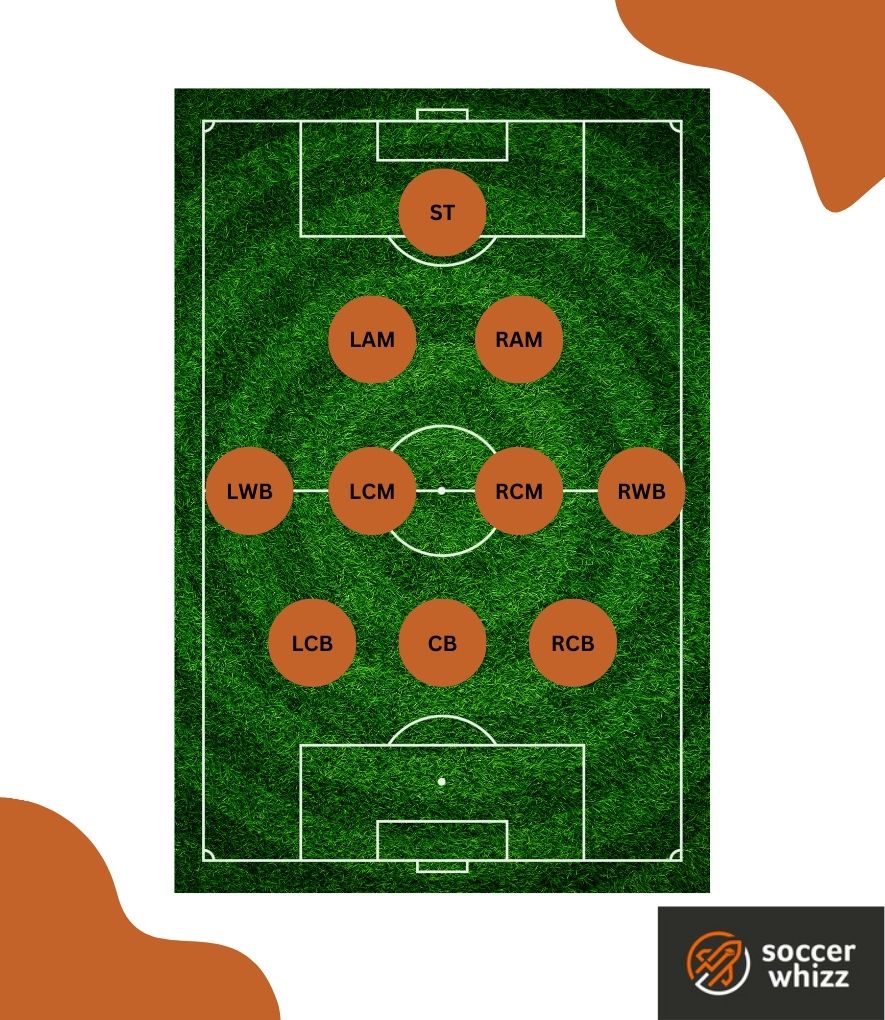In the ever-evolving world of soccer tactics, coaches and managers continually seek innovative ways to gain an edge over their opponents.
One formation that has emerged as a potent weapon in recent years is the 3-4-2-1 formation.
With its unique blend of defensive solidity, midfield dominance, and attacking flair, this tactical setup has captured the imagination of football aficionados and proven to be a game-changer on the pitch.
Throughout this article, we will delve into the intricacies of the 3-4-2-1 formation. We will examine the tactical principles, the roles and responsibilities of each position, and how top teams have successfully implemented it to gain a competitive advantage.
From analyzing the strengths and weaknesses to understanding the key factors for success, we will explore the various nuances that make this formation a potent tool in the modern game.
How does a 3-4-2-1 formation work?
The 3-4-2-1 formation represents a modified version of the attack-oriented 3-4-3 shape, originally conceived by the visionary Johan Cruyff, renowned for his influential role in developing Dutch ‘Total Football‘.
This tactical setup comprises three central defenders, four midfielders, two inside forwards, and a central striker, emphasizing an aggressive approach to the game.

In this formation, the three center-backs (typically a left center-back, a center-back, and a right center-back) each bring distinct qualities to the team.
They should all possess competence in ball possession, with passing ability being of utmost importance.
Furthermore, one of these defenders should excel at reading the game and effectively neutralizing threats, assuming the crucial role of a sweeper or libero, ensuring the defensive line operates at its best.
Supporting the back three is a double pivot in the midfield, where one player tends to focus on defensive responsibilities while the other adopts a box-to-box role.
Positioned on either side of the midfield pivot are wide midfielders or wing-backs, responsible for providing width in the team’s attacking play and contributing defensively when required.
The attacking force is composed of a front three, with a central striker leading the line, complemented by two inside forwards or “number 10s”.
These two players often enjoy considerable creative freedom, although different coaches may deploy them in varying manners to optimize their impact on the game.
What are the strengths of a 3-4-2-1 shape?
The 3-4-2-1 formation proves to be highly advantageous when facing teams with a strong midfield but lacking attacking prowess.
It offers the much-needed flexibility through the wing-backs and the two attacking midfielders, who can drop back and contribute to dominating the midfield battle.
This adaptability becomes especially beneficial for possession-oriented teams, granting them a significant advantage.
Teams that prioritize playing out from the back find the 3-4-2-1 structure highly suitable.
The presence of a midfield double pivot enables seamless ball reception from multiple central defenders, facilitating the initiation of attacks and effective distribution out wide to the wing-backs.
Moreover, the front three can also contribute to width, making the 3-4-2-1 formation particularly potent for teams aiming to absorb possession and rely on counter-attacks for their attacking success.
The array of possibilities and adaptability inherent in this formation makes it an exceptionally challenging proposition for opposing defenses to contend with.
What are the vulnerabilities of this formation that can be exploited?
The role of wing-backs assumes vital significance within the framework of the 3-4-2-1 formation.
This position demands attributes such as speed, industriousness, and exceptional stamina.
In comparison to the 3-4-3 formation, where advanced wingers are typically utilized, the wing-backs in the 3-4-2-1 system bear even greater responsibility for providing width.

Another highly challenging position lies in central midfield.
The two players occupying the midfield double pivot must exhibit a high level of activity in defense, necessitating significant energy, stamina, and physical conditioning.
Additionally, their defensive duties often detract from their involvement in attacking endeavors.
If the team employs central defenders who frequently venture forward, it becomes imperative for the midfielders to consistently offer cover for them.
While the versatility and adaptability of the 3-4-2-1 shape render it a potent tactical formula in various aspects, it entails demanding roles for certain players.
The system can be adjusted based on the characteristics of the opponent, but it is equally susceptible to exploitation if the opposition possesses a comprehensive understanding of how to counter it effectively.
Crucially, players require ample time and patience to develop the necessary proficiency in operating within this system.
Which managers have used the 3-4-2-1 to great success?
1. Brendan Rodgers
During the 2013-14 season, under the guidance of Brendan Rodgers, Liverpool came tantalizingly close to clinching their long-awaited Premier League title.

Rodgers experimented with several formations throughout the campaign, including an innovative 3-4-2-1 structure.
This tactical setup featured the dynamic partnership of Coutinho and the hard-working Adam Lallana in an adaptable attacking midfield duo.
2. Antonio Conte
In the 2016-17 season, under the astute leadership of esteemed Italian coach Antonio Conte, Chelsea showcased an even more impressive rendition of the 3-4-2-1 formation.

The fluidity, exceptional passing ability, and creative brilliance of Eden Hazard and Pedro took center stage.
This transformative season saw Chelsea secure a remarkable Premier League and FA Cup double.
The success of this approach hinged on the effective utilization of wide players.
Conte masterfully converted Victor Moses, previously a winger, and Marcus Alonso, a left-back, into highly productive wing-backs.
Their contributions played a pivotal role in Chelsea’s achievements, adding a dynamic dimension to the team’s attacking prowess.
3. Pep Guardiola
Guardiola’s implementation of the 3-4-2-1 formation at Barcelona was characterized by a strong emphasis on ball possession, intricate passing combinations, and positional fluidity.

The formation provided a solid defensive foundation while maximizing the team’s attacking potential through intelligent movement and interplay.
In defense, three central defenders formed the backbone of the team’s backline.
Typically, these central defenders were composed of Gerard Piqué, Carles Puyol, and one additional player, often Javier Mascherano or Eric Abidal.
The three center-backs would distribute the ball efficiently from the back, initiating Barcelona’s possession-oriented style of play.
The midfield was the engine room of the team, with a double pivot at its core.
Sergio Busquets played a pivotal role as the deep-lying midfielder, acting as the primary link between defense and attack.
Alongside Busquets, two central midfielders, often Xavi and Andrés Iniesta, controlled the tempo of the game, dictating play with their exceptional passing ability and vision.
Is the 3-4-2-1 formation a defensive or offensive tactical system?
The 3-4-2-1 formation can be considered as both a defensive and an offensive tactical system, depending on how it is implemented and the team’s approach to the game.
Defensively, the 3-4-2-1 formation provides a solid structure with three central defenders, which offers increased defensive stability compared to traditional formations with four defenders.
The presence of the extra center-back can provide additional cover and make it difficult for opponents to penetrate the defensive line.
Additionally, the wing-backs in this formation can drop back and help in defensive duties, effectively forming a back five when needed.
This defensive solidity can help protect against opponents’ attacks and make it challenging for them to create scoring opportunities.
Offensively, the 3-4-2-1 formation offers several advantages.
The two attacking midfielders positioned behind the lone striker have the freedom to roam and link up with the central striker, creating intricate passing combinations and exploiting gaps in the opposition’s defense.
These players often have creative freedom, allowing them to provide crucial assists and contribute to goal-scoring opportunities.
The wing-backs also play a crucial role in providing width and stretching the opposition’s defense, creating space for attacking movements.
Concluding thoughts
The 3-4-2-1 formation has proven to be a tactical marvel in the world of soccer.
Its unique blend of defensive stability, midfield dominance, and attacking prowess has captured the imagination of coaches, players, and fans alike.
As we have explored throughout this article, the 3-4-2-1 formation offers a strategic framework that maximizes the strengths of a team while mitigating its weaknesses.
However, as with any formation, the success of the 3-4-2-1 depends on various factors, including the players’ skills and understanding of their roles, the coach’s tactical instructions, and the ability to adapt to different opponents.
Flexibility and effective communication among players are crucial in executing this formation to its full potential.
Should you be interested in reading more about tactical shapes, you can check out our analysis of the following formations:
If you enjoy the content that I create and would like to buy me a coffee, then I’d really appreciate it!
Any money that I earn through this donation will be re-invested into more content for this website.
Additionally, by sending in a donation you’ll also receive a copy of my recently released 190+ page eBook on Soccer Ball Care, as well as be subscribed to our mailing list where you’ll be regularly informed on the latest developments concerning the Soccer Whizz blog.
- Future Icons: Europe’s Emerging Midfield Maestros Set for Glory - December 4, 2023
- Kickstarting a Revolution: How Soccer Transformed the United States Over the Last Four Years - October 7, 2023
- 4-1-4-1 Soccer Formation [Analysis] - September 23, 2023

